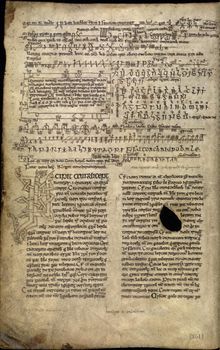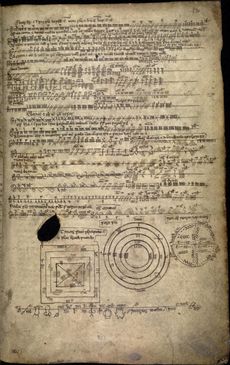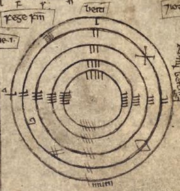
Auraicept na n-Éces
Encyclopedia

The core of the text could indeed date to the mid-7th century, but much material will have been added over the five centuries preceding the text as recorded in the earliest surviving copy (12th century).
If indeed dating to the 7th century, the text is the first instance of a defence of vernacular
Vernacular
A vernacular is the native language or native dialect of a specific population, as opposed to a language of wider communication that is not native to the population, such as a national language or lingua franca.- Etymology :The term is not a recent one...
s, defending the spoken Irish language
Irish language
Irish , also known as Irish Gaelic, is a Goidelic language of the Indo-European language family, originating in Ireland and historically spoken by the Irish people. Irish is now spoken as a first language by a minority of Irish people, as well as being a second language of a larger proportion of...
over Latin
Latin
Latin is an Italic language originally spoken in Latium and Ancient Rome. It, along with most European languages, is a descendant of the ancient Proto-Indo-European language. Although it is considered a dead language, a number of scholars and members of the Christian clergy speak it fluently, and...
, predating Dante's
Dante Alighieri
Durante degli Alighieri, mononymously referred to as Dante , was an Italian poet, prose writer, literary theorist, moral philosopher, and political thinker. He is best known for the monumental epic poem La commedia, later named La divina commedia ...
De vulgari eloquentia
De vulgari eloquentia
De vulgari eloquentia is the title of an essay by Dante Alighieri, written in Latin and initially meant to consist of four books, but abandoned in the middle of the second. It was probably composed shortly after Dante went into exile; internal evidence points to a date between 1302 and 1305...
by 600 years and Chernorizets Hrabar
Chernorizets Hrabar
Chernorizets Hrabar was a Bulgarian monk, scholar and writer who worked at the Preslav Literary School at the end of the 9th and the beginning of the 10th century, developing Medieval Bulgarian literature and spreading Old Church Slavonic.- Name :...
's O pismeneh by 200 years.
Manuscripts
- TCDTrinity College, DublinTrinity College, Dublin , formally known as the College of the Holy and Undivided Trinity of Queen Elizabeth near Dublin, was founded in 1592 by letters patent from Queen Elizabeth I as the "mother of a university", Extracts from Letters Patent of Elizabeth I, 1592: "...we...found and...
H 2.18. (Book of LeinsterBook of LeinsterThe Book of Leinster , is a medieval Irish manuscript compiled ca. 1160 and now kept in Trinity College, Dublin, under the shelfmark MS H 2.18...
), ca. 1160 - TCD H 2.16. (YBL), 14th century
- RIARoyal Irish AcademyThe Royal Irish Academy , based in Dublin, is an all-Ireland, independent, academic body that promotes study and excellence in the sciences, humanities and social sciences. It is one of Ireland's premier learned societies and cultural institutions and currently has around 420 Members, elected in...
23 P 12 (Book of BallymoteBook of BallymoteThe Book of Ballymote , named for the parish of Ballymote, County Sligo, was written in 1390 or 1391....
), foll. 169r–180r, ca. 1390 - BM Eg. 88, 1564
Contents
The Auraicept consists of four books,- I: The Book of Fenius Farsaidh
- II: The Book of AmerginAmerginAmergin, also spelled Amorgen, Amairgin, Aimhirghin, Amorghain, is the name of two poets from Irish mythology:*Amergin Glúingel, poet and druid of the Mythological Cycle*Amergin mac Eccit, poet and hero of the Ulster Cycle...
- III: The Book of Fercheirtne Filidh
- IV: The Book of Cennfaeladh
The author argues from a comparison of Gaelic grammar with the materials used in the constructions of the Tower of Babel
Tower of Babel
The Tower of Babel , according to the Book of Genesis, was an enormous tower built in the plain of Shinar .According to the biblical account, a united humanity of the generations following the Great Flood, speaking a single language and migrating from the east, came to the land of Shinar, where...
:
- Others affirm that in the tower there were only nine materials and that these were clayClayClay is a general term including many combinations of one or more clay minerals with traces of metal oxides and organic matter. Geologic clay deposits are mostly composed of phyllosilicate minerals containing variable amounts of water trapped in the mineral structure.- Formation :Clay minerals...
and waterWaterWater is a chemical substance with the chemical formula H2O. A water molecule contains one oxygen and two hydrogen atoms connected by covalent bonds. Water is a liquid at ambient conditions, but it often co-exists on Earth with its solid state, ice, and gaseous state . Water also exists in a...
, woolWoolWool is the textile fiber obtained from sheep and certain other animals, including cashmere from goats, mohair from goats, qiviut from muskoxen, vicuña, alpaca, camel from animals in the camel family, and angora from rabbits....
and bloodBloodBlood is a specialized bodily fluid in animals that delivers necessary substances such as nutrients and oxygen to the cells and transports metabolic waste products away from those same cells....
, woodWoodWood is a hard, fibrous tissue found in many trees. It has been used for hundreds of thousands of years for both fuel and as a construction material. It is an organic material, a natural composite of cellulose fibers embedded in a matrix of lignin which resists compression...
and lime, pitchPitch (resin)Pitch is the name for any of a number of viscoelastic, solid polymers. Pitch can be made from petroleum products or plants. Petroleum-derived pitch is also called bitumen. Pitch produced from plants is also known as resin. Products made from plant resin are also known as rosin.Pitch was...
, linenLinenLinen is a textile made from the fibers of the flax plant, Linum usitatissimum. Linen is labor-intensive to manufacture, but when it is made into garments, it is valued for its exceptional coolness and freshness in hot weather....
, and bitumen [...] These represent noun, pronoun, verb, adverb, participle, conjunction, preposition, interjection
(note the discrepancy of nine materials vs. eight parts of speech). As pointed out by Eco (1993), Gaelic was thus argued to be the only instance of a language that overcame the confusion of tongues
Confusion of tongues
The confusion of tongues is the initial fragmentation of human languages described in the Book of Genesis 11:1–9, as a result of the construction of the Tower of Babel....
, being the first language that was created after the fall of the tower by the seventy-two wise men of the school of Fenius, choosing all that was best in each language to implement in Irish. Calder notes (p. xxxii) that the poetic list of the "72 races" was taken from a poem by Luccreth moccu Chiara
Luccreth moccu Chiara
Luccreth moccu Chíara was a poet from County Kerry, Ireland who wrote in archaic Old Irish. Moccu is an archaic form marking affiliation to an ancestral population group or gens, in this case the Cíarraige...
.
Ogham
The Auraicept is one of the three main sources of the manuscript tradition about OghamOgham
Ogham is an Early Medieval alphabet used primarily to write the Old Irish language, and occasionally the Brythonic language. Ogham is sometimes called the "Celtic Tree Alphabet", based on a High Medieval Bríatharogam tradition ascribing names of trees to the individual letters.There are roughly...
, the others being In Lebor Ogaim
In Lebor Ogaim
In Lebor Ogaim , also known as the Ogam Tract, is an Old Irish treatise on the ogham alphabet. It is preserved in R.I.A. MS 23 P 12 308-314 , T.C.D. H.3.18, 26.1-35.28 and National Library of Ireland MS G53 1-22 , and fragments in British Library Add. 4783...
and De dúilib feda na forfed. A copy of In Lebor Ogaim immediately precedes the Auraincept in the Book of Ballymote, but instead of the Bríatharogam
Bríatharogam
In Early Irish literature a Bríatharogam is a two word kenning which explains the meanings of the names of the letters of the Ogham alphabet. Three variant lists of bríatharogaim or 'word-oghams' have been preserved, dating to the Old Irish period...
Con Culainn given in other copies, there follows a variety of other "secret" modes of ogham. The Younger Futhark
Younger Futhark
The Younger Futhark, also called Scandinavian runes, is a runic alphabet, a reduced form of the Elder Futhark, consisting of only 16 characters, in use from ca. 800 CE...
are also included, as ogam lochlannach "ogham of the Norsemen".

Fenius Farsa
Fénius Farsaid is a legendary king of Scythia who shows up in different versions of Irish folklore. He was the son of Bathath who was a son of Magog...
idh discovered four alphabets, the Hebrew
Hebrew alphabet
The Hebrew alphabet , known variously by scholars as the Jewish script, square script, block script, or more historically, the Assyrian script, is used in the writing of the Hebrew language, as well as other Jewish languages, most notably Yiddish, Ladino, and Judeo-Arabic. There have been two...
, Greek
Greek alphabet
The Greek alphabet is the script that has been used to write the Greek language since at least 730 BC . The alphabet in its classical and modern form consists of 24 letters ordered in sequence from alpha to omega...
and Latin
Latin alphabet
The Latin alphabet, also called the Roman alphabet, is the most recognized alphabet used in the world today. It evolved from a western variety of the Greek alphabet called the Cumaean alphabet, which was adopted and modified by the Etruscans who ruled early Rome...
ones, and finally the ogham
Ogham
Ogham is an Early Medieval alphabet used primarily to write the Old Irish language, and occasionally the Brythonic language. Ogham is sometimes called the "Celtic Tree Alphabet", based on a High Medieval Bríatharogam tradition ascribing names of trees to the individual letters.There are roughly...
, and that the ogham is the most perfected because it was discovered last. The text is the origin of the tradition that the ogham letters were named after trees, but it gives as an alternative possibility that the letters are named for the 25 members of Fenius' school.
In the translation of Calder (1917),
- This is their number: five Oghmic groups, i.e., five men for each group, and one up to five for each of them, that their signs may be distinguished. These are their signs: right of stem, left of stem, athwart of stem, through stem, about stem. Thus is a tree climbed, to wit, treading on the root of the tree first with thy right hand first and thy left hand after. Then with the stem, and against it and through it and about it. (Lines 947-951)
In the translation of McManus:
- This is their number: there are five groups of ogham and each group has five letters and each of them has from one to five scores and their orientations distinguish them. Their orientations are: right of the stemline, left of the stemline, across the stemline, through the stemline, around the stemline. Ogham is climbed as a tree is climbed..."

Editions
- Calder, George, Edinburgh, John Grant (1917), reprint Four Courts Press (1995), ISBN 1851821813 http://www.four-courts-press.ie/cgi/bookshow.cgi?file=a_eces.xml

